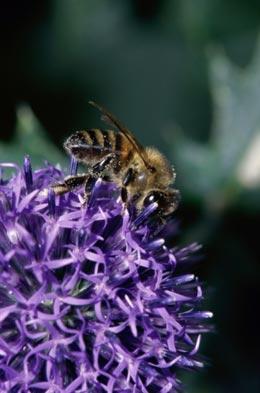Global crop yields have not suffered even though key insect populations have shrunk.
 Crops may not need quite so many bees for pollination after all.Punchstock
Crops may not need quite so many bees for pollination after all.PunchstockBees and many other insects may be in decline almost everywhere — but agriculture that depends on pollinators has been surprisingly unaffected at the global scale.
That's the conclusion of a study by Alexandra Klein at the University of California, Berkeley, and her colleagues. Using a data set of global crop production — maintained by the Food and Agriculture Organisation of the United Nations (FAO) — which spanned 1961 to 2006, they compared the yields of crops that require pollinators with those that don't.
They found that crop yields for both crop types have gone up consistently, seeing average annual growth rates of about 1.5%. There was also no difference when the researchers split the data into crops from developing countries and crops from developed countries.
And when the researchers compared crops that are cultivated almost exclusively in tropical regions, they found no difference between the success of insect-pollinated crops — such as oil palm, cocoa and the Brazil nut — and those crops that need only the breeze to spread their pollen.
Underplayed, overplayed
The results, published in Current Biology1, are surprising because several previous studies have found very large impacts at local scales. Taylor Ricketts, head of conservation group WWF's conservation science programme, and his colleagues, reported in 2004 that pollinators increased coffee yields by 20% on plants growing a kilometre or less from forests in Costa Rica2.
In 2005, a team led by Jacobus Biesmeijer of the University of Leeds, UK, found evidence of a drop-off in bee diversity in the United Kingdom and the Netherlands3. This coincided with a decline in outcrossing plant species relative to other sorts of plants.
And worries about a pollination crisis have found their way into international politics, most prominently with the establishment of the International Initiative for the Conservation and Sustainable Use of Pollinators (IPI) at a United Nations meeting in 2000.
But some scientists think that the pollinator crisis is overplayed. Jaboury Ghazoul, a plant ecologist at ETH Zurich, Switzerland, has argued that it is driven mainly by reported declines of crop-pollinating honeybees in North America and bumblebees and butterflies in Europe4.
Other data show that native pollinator communities elsewhere exhibit mixed responses to environmental change, and Ghazoul says that few staple food crops depend on insect pollinators.
"When the IPI was established, there was some disagreement about how much pollinators are declining," says Linda Collette, a senior officer on crop associated biodiversity at the FAO, which oversees the IPI programme.
Hidden threat
Klein says her findings do not necessarily negate that idea that the world is in the throes of a pollination crisis. The data might hide how farmers have adapted to the problem, she suggests.
For example, in almond pollination, many growers move honeybees into their orchards and use pheromones to stimulate foraging activity, she says. Some even place compatible pollen in the bees' hives so that they transport it to the desired variety of almond. And many passion-fruit growers in Brazil now pollinate crops by hand.
For the FAO, the increasing reliance on farmworkers rather than insects may not represent a crisis. "At the end of the day, what's important to the FAO is crop production," says Collette. "There may be labour costs involved in pollinating crops but there could also be market benefits — if the fruits are better from that, for instance."
However, Klein points out that a sudden drop in crop yields could be just around the corner. "There could be a more widespread threshold effect coming," she says, "especially if the honeybee problems get worse in places like California."
This may be more likely as farmers all over the planet start to fill ever more hectares with pollinator-dependent crops, which contributed 8.4% of total agricultural production in the developed world in 1961 but 14.7% in 2006. "We assume that the trend will continue as many biofuels crops, such as canola, oil palm and jatropha, are pollinator-dependent plants," says Klein.



No comments:
Post a Comment